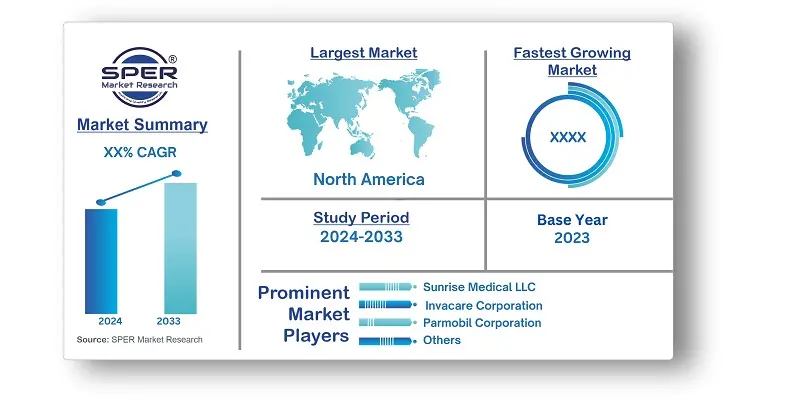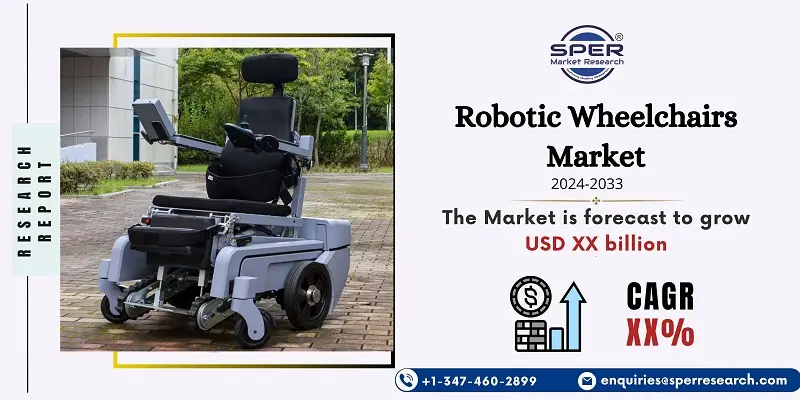
Robotic Wheelchairs Market Growth, Size, Trends, Demand, Share, Revenue and Future Outlook
Robotic Wheelchairs Market Size- By Application, By End User, By Distribution Channel- Regional Outlook, Competitive Strategies and Segment Forecast to 2033
| Published: May-2024 | Report ID: FMCG24103 | Pages: 1 - 224 | Formats*: |
| Category : Consumer & Retail | |||
- March 2022; The Netti Dynamic Adaptpro product line was introduced by Netti, and Myera GmbH was established. The device has a 500mm turning radius without the need for leg support, easy maneuverability, and a full dynamic setup.
- February 2020; Sunrise Medical buys Oracing to provide appropriate products to meet the needs of a broad audience in the rapidly expanding market.


| Report Metric | Details |
| Market size available for years | 2020-2033 |
| Base year considered | 2023 |
| Forecast period | 2024-2033 |
| Segments covered | By Application, By End User, By Distribution Channel |
| Regions covered | North America, Asia-Pacific, Latin America, Middle East & Africa and Europe |
| Companies Covered | Sunrise Medical LLC, Invacare Corporation, Parmobil Corporation, Meyra GmbH, Karman Healthcare, Otobok SE Co, Matia Robotics, Upnaride Robotics, Deka Research and Development, Will Inc. |
- Individuals with spinal cord injuries (SCIs)
- People with Multiple Sclerosis (MS)
- Stroke survivors
- People with Cerebral Palsy (CP)
- Older adults with age-related mobility decline
- People with amputations
- Visually impaired individuals
- People with chronic fatigue
- Children with disabilities
- Healthcare facilities
| By Application: |
|
| By End User: |
|
| By Distribution Channel: |
|
- Global Robotic Wheelchairs Market Size (FY’2024-FY’2033)
- Overview of Global Robotic Wheelchairs Market
- Segmentation of Global Robotic Wheelchairs Market By Application (Residential, Commercial)
- Segmentation of Global Robotic Wheelchairs Market By End User (Male, Female)
- Segmentation of Global Robotic Wheelchairs Market By Distribution Channel (Retail, Supermarket, E- commerce, Others)
- Statistical Snap of Global Robotic Wheelchairs Market
- Expansion Analysis of Global Robotic Wheelchairs Market
- Problems and Obstacles in Global Robotic Wheelchairs Market
- Competitive Landscape in the Global Robotic Wheelchairs Market
- Impact of COVID-19 and Demonetization on Global Robotic Wheelchairs Market
- Details on Current Investment in Global Robotic Wheelchairs Market
- Competitive Analysis of Global Robotic Wheelchairs Market
- Prominent Players in the Global Robotic Wheelchairs Market
- SWOT Analysis of Global Robotic Wheelchairs Market
- Global Robotic Wheelchairs Market Future Outlook and Projections (FY’2024-FY’2033)
- Recommendations from Analyst
1.1. Scope of the report1.2. Market segment analysis
2.1. Research data source2.1.1. Secondary Data2.1.2. Primary Data2.1.3. SPER’s internal database2.1.4. Premium insight from KOL’s2.2. Market size estimation2.2.1. Top-down and Bottom-up approach2.3. Data triangulation
4.1. Driver, Restraint, Opportunity and Challenges analysis4.1.1. Drivers4.1.2. Restraints4.1.3. Opportunities4.1.4. Challenges4.2. COVID-19 Impacts of the Global Robotic Wheelchairs Market
5.1. SWOT Analysis5.1.1. Strengths5.1.2. Weaknesses5.1.3. Opportunities5.1.4. Threats5.2. PESTEL Analysis5.2.1. Political Landscape5.2.2. Economic Landscape5.2.3. Social Landscape5.2.4. Technological Landscape5.2.5. Environmental Landscape5.2.6. Legal Landscape5.3. PORTER’s Five Forces5.3.1. Bargaining power of suppliers5.3.2. Bargaining power of buyers5.3.3. Threat of Substitute5.3.4. Threat of new entrant5.3.5. Competitive rivalry5.4. Heat Map Analysis
6.1. Global Robotic Wheelchairs Market Manufacturing Base Distribution, Sales Area, Product Type6.2. Mergers & Acquisitions, Partnerships, Product Launch, and Collaboration in Global Robotic Wheelchairs Market
7.1. Global Robotic Wheelchairs Market Size, Share and Forecast, By Application, 2020-20267.2. Global Robotic Wheelchairs Market Size, Share and Forecast, By Application, 2027-20337.3. Residential7.4. Commercial
8.1. Global Robotic Wheelchairs Market Size, Share and Forecast, By End User, 2020-20268.2. Global Robotic Wheelchairs Market Size, Share and Forecast, By End User, 2027-20338.3. Male8.4. Female
9.1. Global Robotic Wheelchairs Market Size, Share and Forecast, By Distribution Channel, 2020-20269.2. Global Robotic Wheelchairs Market Size, Share and Forecast, By Distribution Channel, 2027-20339.3. Retail9.4. Supermarket9.5. E-commerce9.6. Others
10.1. Global Robotic Wheelchairs Market Size and Market Share
11.1. Global Robotic Wheelchairs Market Size and Market Share By Region (2020-2026)11.2. Global Robotic Wheelchairs Market Size and Market Share By Region (2027-2033)11.3. Asia-Pacific11.3.1. Australia11.3.2. China11.3.3. India11.3.4. Japan11.3.5. South Korea11.3.6. Rest of Asia-Pacific11.4. Europe11.4.1. France11.4.2. Germany11.4.3. Italy11.4.4. Spain11.4.5. United Kingdom11.4.6. Rest of Europe11.5. Middle East and Africa11.5.1. Kingdom of Saudi Arabia11.5.2. United Arab Emirates11.5.3. Qatar11.5.4. South Africa11.5.5. Egypt11.5.6. Morocco11.5.7. Nigeria11.5.8. Rest of Middle East & Africa11.6. North America11.6.1. Canada11.6.2. Mexico11.6.3. United States11.7. Latin America11.7.1. Argentina11.7.2. Brazil11.7.3. Rest of Latin America
12.1. Deka Research and Development12.1.1. Company details12.1.2. Financial outlook12.1.3. Product summary12.1.4. Recent developments12.2. Invacare Corporation12.2.1. Company details12.2.2. Financial outlook12.2.3. Product summary12.2.4. Recent developments12.3. Karman Healthcare12.3.1. Company details12.3.2. Financial outlook12.3.3. Product summary12.3.4. Recent developments12.4. Matia Robotics12.4.1. Company details12.4.2. Financial outlook12.4.3. Product summary12.4.4. Recent developments12.5. Meyra GmbH12.5.1. Company details12.5.2. Financial outlook12.5.3. Product summary12.5.4. Recent developments12.6. Otobok SE Co.12.6.1. Company details12.6.2. Financial outlook12.6.3. Product summary12.6.4. Recent developments12.7. Parmobil Corporation12.7.1. Company details12.7.2. Financial outlook12.7.3. Product summary12.7.4. Recent developments12.8. Sunrise Medical LLC12.8.1. Company details12.8.2. Financial outlook12.8.3. Product summary12.8.4. Recent developments12.9. Upnaride Robotics12.9.1. Company details12.9.2. Financial outlook12.9.3. Product summary12.9.4. Recent developments12.10. Will Inc.12.10.1. Company details12.10.2. Financial outlook12.10.3. Product summary12.10.4. Recent developments12.11. Others
SPER Market Research’s methodology uses great emphasis on primary research to ensure that the market intelligence insights are up to date, reliable and accurate. Primary interviews are done with players involved in each phase of a supply chain to analyze the market forecasting. The secondary research method is used to help you fully understand how the future markets and the spending patterns look likes.
The report is based on in-depth qualitative and quantitative analysis of the Product Market. The quantitative analysis involves the application of various projection and sampling techniques. The qualitative analysis involves primary interviews, surveys, and vendor briefings. The data gathered as a result of these processes are validated through experts opinion. Our research methodology entails an ideal mixture of primary and secondary initiatives.



Frequently Asked Questions About This Report
PLACE AN ORDER
Year End Discount
Sample Report
Pre-Purchase Inquiry
NEED CUSTOMIZATION?
Request CustomizationCALL OR EMAIL US
100% Secure Payment






Related Reports
Our Global Clients
Our data-driven insights have influenced the strategy of 200+ reputed companies across the globe.






















